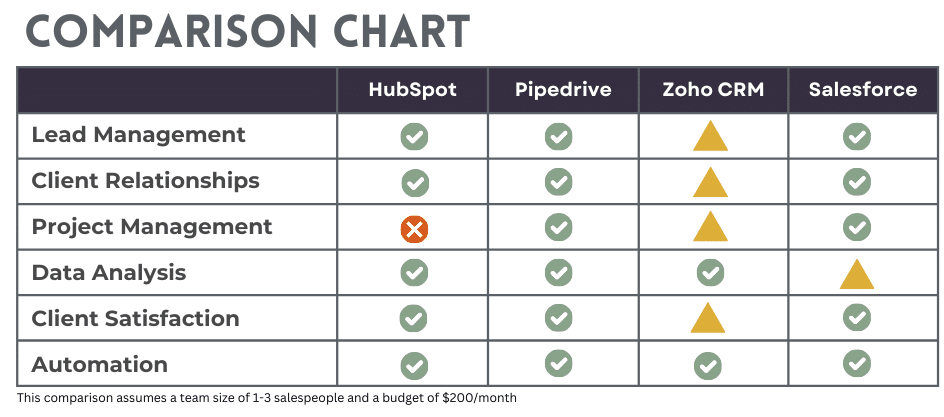Contractors often face challenges when managing multiple client relationships and projects simultaneously. Many rely on outdated methods, leading to inefficiencies and missed opportunities. In this guide, we’ll explore the common issues contractors encounter and how CRM systems can help:
- Finding and Managing Leads
- Nurturing Relationships with Existing Clients
- Organizing and Managing Projects
- Gathering and Analyzing Data
- Boosting Client Satisfaction
- Saving Time with Automation
Finding and Managing Leads
Current Method Contractors Use (Example):
A small landscaping business typically manages incoming leads through phone calls, emails, or spreadsheets. During busy seasons, they often lose track of some leads or fail to follow up, resulting in missed opportunities. The manual tracking system creates chaos, making it difficult to prioritize high-value clients.
Downside:
Managing leads manually is time-consuming and prone to errors. Without a follow-up system, valuable business opportunities can slip through the cracks, potentially leading to significant revenue loss.
How a CRM Can Help:
A CRM provides an organized system to capture and track leads, automating follow-ups, and prioritizing prospects based on their engagement. This ensures no lead is forgotten, helping you focus on the ones most likely to convert into clients.
Want a tailored recommendation to help manage leads more effectively?
Contact us today, and we’ll recommend the best CRM based on your needs.
Nurturing Relationships with Existing Clients
Current Method Contractors Use (Example):
A roofing contractor often relies on memory or scattered reminders to follow up with clients for maintenance or additional services. This inconsistent approach leads to missed follow-ups, resulting in lost repeat business and client dissatisfaction.
Downside:
Without a centralized way to track client interactions, it’s easy to forget important follow-ups, reducing the chances of repeat business and making it harder to build long-term client relationships.
How a CRM Can Help:
A CRM centralizes client data, automating follow-up reminders, and tracking interactions, ensuring you maintain consistent communication with clients and never miss an opportunity for repeat business.
Looking for a way to nurture client relationships effectively?
Contact us, and we’ll help you choose the right CRM for your business.
Organizing and Managing Projects
Current Method Contractors Use (Example):
A general contractor often uses Excel or whiteboards to track project progress. This manual system can lead to delays, miscommunication among team members, and forgotten tasks, which ultimately affect client satisfaction.
Downside:
Disparate tools make it difficult to coordinate projects, leading to poor team collaboration and missed deadlines. This can harm your reputation and make clients feel disconnected from the process.
How a CRM Can Help:
A CRM system integrates with project management tools, allowing you to assign tasks, set deadlines, and monitor progress in real-time, keeping everyone on the same page and ensuring projects stay on track.
Want help streamlining your project management?
Contact us to discover the best CRM for organizing and managing your projects
Gathering and Analyzing Data
Current Method Contractors Use (Example):
A home remodeling contractor may rely on gut instinct rather than data to determine which projects are most profitable. They lack insight into lead sources, project profitability, and customer retention rates.
Downside:
Without proper data analysis, it’s impossible to identify the most profitable types of projects or which marketing efforts yield the best clients. This can result in wasted resources and missed growth opportunities.
How a CRM Can Help:
A CRM collects and analyzes key business data, helping you understand lead sources, project profitability, and client retention trends, enabling data-driven decisions to improve business outcomes.
Need help leveraging data to grow your business?
Reach out, and we’ll guide you toward the best CRM for analyzing your data.
Boosting Client Satisfaction
Current Method Contractors Use (Example):
A custom home builder often relies on sporadic phone calls and emails to update clients about their projects. This inconsistent communication can lead to client frustration and dissatisfaction.
Downside:
Without a clear, centralized way to communicate with clients, updates can be delayed or missed, leading to negative reviews and fewer referrals.
How a CRM Can Help:
A CRM keeps clients updated by automating progress reports, providing access to project timelines, and allowing clients to view essential documents, improving communication and satisfaction.
Want to ensure your clients stay informed and satisfied?
Contact us to discuss how the right CRM can enhance client communication.
Saving Time with Automation
Current Method Contractors Use (Example):
An HVAC contractor spends hours every week manually following up on appointments and sending invoices, leaving little time to focus on growing the business.
Downside:
Manual administrative tasks like invoicing and scheduling are time-consuming and prone to error, making it harder to focus on high-value activities like client acquisition and project management.
How a CRM Can Help:
A CRM automates routine tasks like invoicing, appointment scheduling, and reminders, freeing up your time to focus on growing your business.
Ready to save time and boost efficiency with automation?
Reach out to us, and we’ll recommend the best CRM solution tailored to your business needs.

Legend
- Red X: Lacks functionality.
- Yellow Triangle: Good, but has limitations.
- Green Check: Excellent performance.
Why Pipedrive is the Top Recommendation:
- Lead Management: Pipedrive excels in focusing on sales leads with a well-designed sales pipeline, making it easy to manage and prioritize.
- Client Relationships: Customizable follow-ups and great tracking of interactions make Pipedrive excellent for maintaining strong client relationships.
- Project Management: It integrates well with task management tools, making it suitable for small-to-medium-sized contractors.
- Automation: Pipedrive shines in automation, streamlining follow-ups, deal progress, and reminders effortlessly.
For an all-around solution that excels in lead management, client relationships, and automation, Pipedrive is our top recommendation. Schedule a free call with us to find out how Pipedrive can fit your specific needs and help grow your business.
Final Thoughts
By leveraging CRM systems like HubSpot, Pipedrive, Zoho, or Salesforce, contractors can streamline their operations, improve client communication, and manage projects more effectively. From automating follow-ups to gathering actionable data, these tools empower contractors to grow their businesses without getting bogged down in manual processes.
If you’re ready to take your business to the next level and start benefiting from powerful CRM integrations and automated workflows, it’s worth exploring solutions that fit your unique needs. Whether you’re looking for seamless client communication, automated task management, or detailed project tracking, investing in the right tools can make all the difference. Contractors of all sizes are adopting CRMs to enhance efficiency, save time, and improve client satisfaction.
For those looking to build scalable systems that work for your business, visit Cosmoforge.io to discover how you can optimize your processes and maximize your results with tailored marketing and CRM solutions. Every contractor deserves the tools that allow them to focus on growth while ensuring nothing falls through the cracks.




